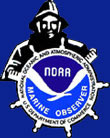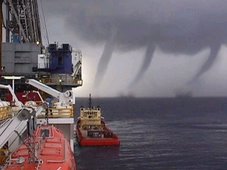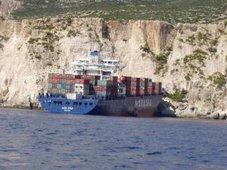 MAIB publishes report of FR8 VENTURE Tragedy.
MAIB publishes report of FR8 VENTURE Tragedy. Report into incident on tanker on 11th November 2006 which resulted in fatalities.
At about 1220 on 11 November 2006, while outbound from Scapa Flow and transiting the Pentland Firth, the 74,065 dwt Singaporean registered tanker, FR8 VENTURE, shipped two large waves over her bow. This resulted in the death of two able seamen (ABs) and serious injuries to an ordinary seaman (OS), all of whom were working on the forward mooring deck. The waves also caused minor damage to the ship.
From 10 to 11 November, FR8 VENTURE carried out a ship-to-ship transfer with another tanker, Perseverance, while at anchor in Scapa Flow, and loaded a full cargo of crude oil. The loading operations were completed at 0536, and Perseverance let go from FR8 VENTURE and left Scapa Flow. FR8 VENTURE weighed anchor at about 1054 and the two pilots disembarked near the entrance to Scapa Flow at about 1136. The wind was west to west-north-west and near gale force, with waves of about 4 to 5m high. The ship’s freeboard was about 6.6m and spray was being shipped on board. The tidal stream was flowing generally in the same direction as the wind.
After weighing anchor, the bosun and AB Kharva secured the port anchor, and began stowing three loose mooring lines down into the forward storeroom. AB Ravindra and an OS were stowing loose mooring lines away aft. At about 1210, the chief officer told AB Ravindra and the OS to go forward and help the bosun. AB Ravindra joined AB Kharva on the starboard winch platform to lash canvas covers around the mooring wires. The bosun instructed the OS to place a securing wire through the starboard anchor cable. At about 1220, just as the OS turned towards the anchor cable, a large wave was shipped over the bow. The ship pitched into the following trough and then a second larger wave was shipped on board. The two ABs were swept aft, towards and under the flying bridge. The OS was swept aft and came into contact with a protection plate for the forward liferaft. The bosun had managed to cling onto the storeroom door when the first wave was shipped, and then onto the ladder rungs of the foremast as the second wave swept over the foredeck; he remained uninjured.
The bridge team saw the seas being shipped on deck. The third officer released a manoverboard lifebuoy and smoke float from the bridge wing, and the general alarm was sounded, upon which the crew mustered at the emergency station. The OS managed to walk aft until he reached amidships, where he collapsed. All three injured men were taken to the accommodation.
FR8 VENTURE called Orkney Harbour Control to report the accident and to state that medical assistance would be needed. Orkney Harbour Control then informed Shetland Coastguard of the tanker’s emergency. Later, Shetland Coastguard arranged a radio telephone link between the ship’s master and a doctor at Aberdeen Royal Infirmary. The Longhope RNLI lifeboat took the local doctor out to meet the ship, but the rough seas prevented the doctor from boarding the ship from the lifeboat. However, the Stornoway Coastguard rescue helicopter was able to transfer her to FR8 VENTURE.
Once onboard the vessel, the doctor determined that the two ABs had died of their injuries and the OS should be taken to hospital. The helicopter returned to the ship, landed an Orkney Harbour pilot and airlifted the doctor and the OS to Aberdeen Royal Infirmary. The ship returned to Scapa Flow and anchored there at about 1800.
The investigation identified the following safety issues:
• The two large waves that were shipped over the bow could not have been considered abnormal and should have been expected in the prevailing weather conditions.
• The master should have delayed the sailing so that the ship could have been secured for sea in sheltered waters.
• Having decided to leave the shelter of Scapa Flow before the foredecks were secured for sea, the master’s assessment of the position by which the crew should have been clear of the foredeck of the ship allowed little margin for error. This should have prompted an effective plan of action.
• The plan could have concentrated the crew forward earlier, leaving the stowing of the after ropes until the fore part of the vessel had been secured.
• The plan should have prompted the need for precautionary measures, such as considering the option of turning the ship away from the weather, when safe and practicable to do so, to secure the anchors.
The managers of FR8 VENTURE have reviewed and amended their company SMS procedures for working on deck in heavy weather.
The relevant sections are as follows:
• The priority, which Master and Deck Officers should have is to ensure that when the vessel is either arriving or leaving port, the unsecuring or securing should be done as later or early as possible (basis whether vessel is arriving port or departing port) to ensure that crew are on deck and exposed to the elements for the least possible time.
• When departing port, most of the securing should be done prior leaving the berth or anchorage.
• When the vessel has left the berth or anchorage, the guiding principle should be to secure the vessel from forward to aft.
• It would be prudent to concentrate the manpower in one locale rather than spreading them out and trying to secure all over as a concentrated effort will mean a quicker securing [sic].
The MCA has issued a Safety Alert, which gives a brief outline of the accident and draws attention to the contents of Chapter 3 of the Admiralty Sailing Directions North Coast of Scotland Pilot, which warns mariners of strong tides, with large waves that frequently occur in the area of Pentland Firth.
In light of the actions taken as a result of this accident, the MAIB has issued no safety recommendations.
RS
From 10 to 11 November, FR8 VENTURE carried out a ship-to-ship transfer with another tanker, Perseverance, while at anchor in Scapa Flow, and loaded a full cargo of crude oil. The loading operations were completed at 0536, and Perseverance let go from FR8 VENTURE and left Scapa Flow. FR8 VENTURE weighed anchor at about 1054 and the two pilots disembarked near the entrance to Scapa Flow at about 1136. The wind was west to west-north-west and near gale force, with waves of about 4 to 5m high. The ship’s freeboard was about 6.6m and spray was being shipped on board. The tidal stream was flowing generally in the same direction as the wind.
After weighing anchor, the bosun and AB Kharva secured the port anchor, and began stowing three loose mooring lines down into the forward storeroom. AB Ravindra and an OS were stowing loose mooring lines away aft. At about 1210, the chief officer told AB Ravindra and the OS to go forward and help the bosun. AB Ravindra joined AB Kharva on the starboard winch platform to lash canvas covers around the mooring wires. The bosun instructed the OS to place a securing wire through the starboard anchor cable. At about 1220, just as the OS turned towards the anchor cable, a large wave was shipped over the bow. The ship pitched into the following trough and then a second larger wave was shipped on board. The two ABs were swept aft, towards and under the flying bridge. The OS was swept aft and came into contact with a protection plate for the forward liferaft. The bosun had managed to cling onto the storeroom door when the first wave was shipped, and then onto the ladder rungs of the foremast as the second wave swept over the foredeck; he remained uninjured.
The bridge team saw the seas being shipped on deck. The third officer released a manoverboard lifebuoy and smoke float from the bridge wing, and the general alarm was sounded, upon which the crew mustered at the emergency station. The OS managed to walk aft until he reached amidships, where he collapsed. All three injured men were taken to the accommodation.
FR8 VENTURE called Orkney Harbour Control to report the accident and to state that medical assistance would be needed. Orkney Harbour Control then informed Shetland Coastguard of the tanker’s emergency. Later, Shetland Coastguard arranged a radio telephone link between the ship’s master and a doctor at Aberdeen Royal Infirmary. The Longhope RNLI lifeboat took the local doctor out to meet the ship, but the rough seas prevented the doctor from boarding the ship from the lifeboat. However, the Stornoway Coastguard rescue helicopter was able to transfer her to FR8 VENTURE.
Once onboard the vessel, the doctor determined that the two ABs had died of their injuries and the OS should be taken to hospital. The helicopter returned to the ship, landed an Orkney Harbour pilot and airlifted the doctor and the OS to Aberdeen Royal Infirmary. The ship returned to Scapa Flow and anchored there at about 1800.
The investigation identified the following safety issues:
• The two large waves that were shipped over the bow could not have been considered abnormal and should have been expected in the prevailing weather conditions.
• The master should have delayed the sailing so that the ship could have been secured for sea in sheltered waters.
• Having decided to leave the shelter of Scapa Flow before the foredecks were secured for sea, the master’s assessment of the position by which the crew should have been clear of the foredeck of the ship allowed little margin for error. This should have prompted an effective plan of action.
• The plan could have concentrated the crew forward earlier, leaving the stowing of the after ropes until the fore part of the vessel had been secured.
• The plan should have prompted the need for precautionary measures, such as considering the option of turning the ship away from the weather, when safe and practicable to do so, to secure the anchors.
The managers of FR8 VENTURE have reviewed and amended their company SMS procedures for working on deck in heavy weather.
The relevant sections are as follows:
• The priority, which Master and Deck Officers should have is to ensure that when the vessel is either arriving or leaving port, the unsecuring or securing should be done as later or early as possible (basis whether vessel is arriving port or departing port) to ensure that crew are on deck and exposed to the elements for the least possible time.
• When departing port, most of the securing should be done prior leaving the berth or anchorage.
• When the vessel has left the berth or anchorage, the guiding principle should be to secure the vessel from forward to aft.
• It would be prudent to concentrate the manpower in one locale rather than spreading them out and trying to secure all over as a concentrated effort will mean a quicker securing [sic].
The MCA has issued a Safety Alert, which gives a brief outline of the accident and draws attention to the contents of Chapter 3 of the Admiralty Sailing Directions North Coast of Scotland Pilot, which warns mariners of strong tides, with large waves that frequently occur in the area of Pentland Firth.
In light of the actions taken as a result of this accident, the MAIB has issued no safety recommendations.
RS


































































































![Validate my RSS feed [Valid RSS]](valid-rss.png)